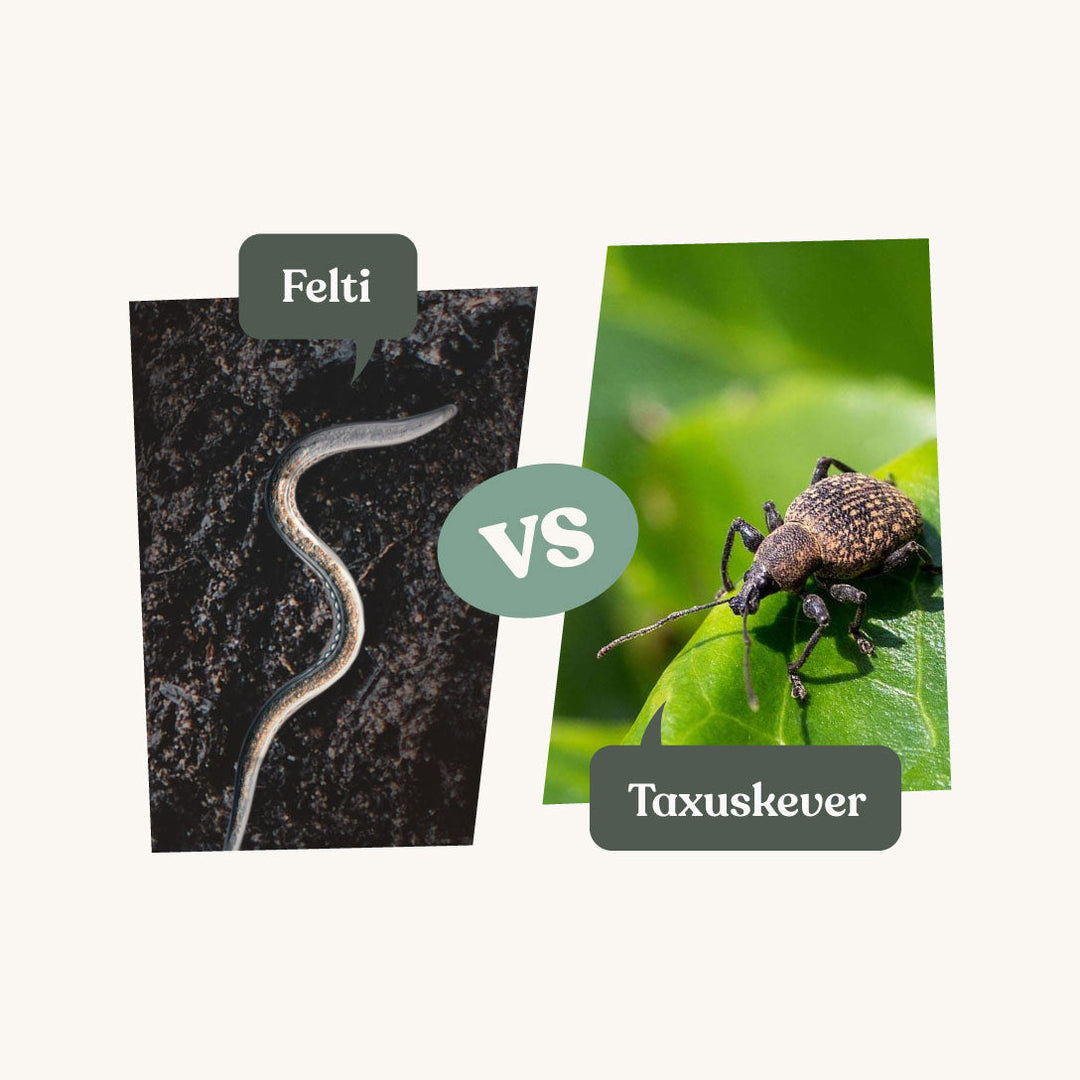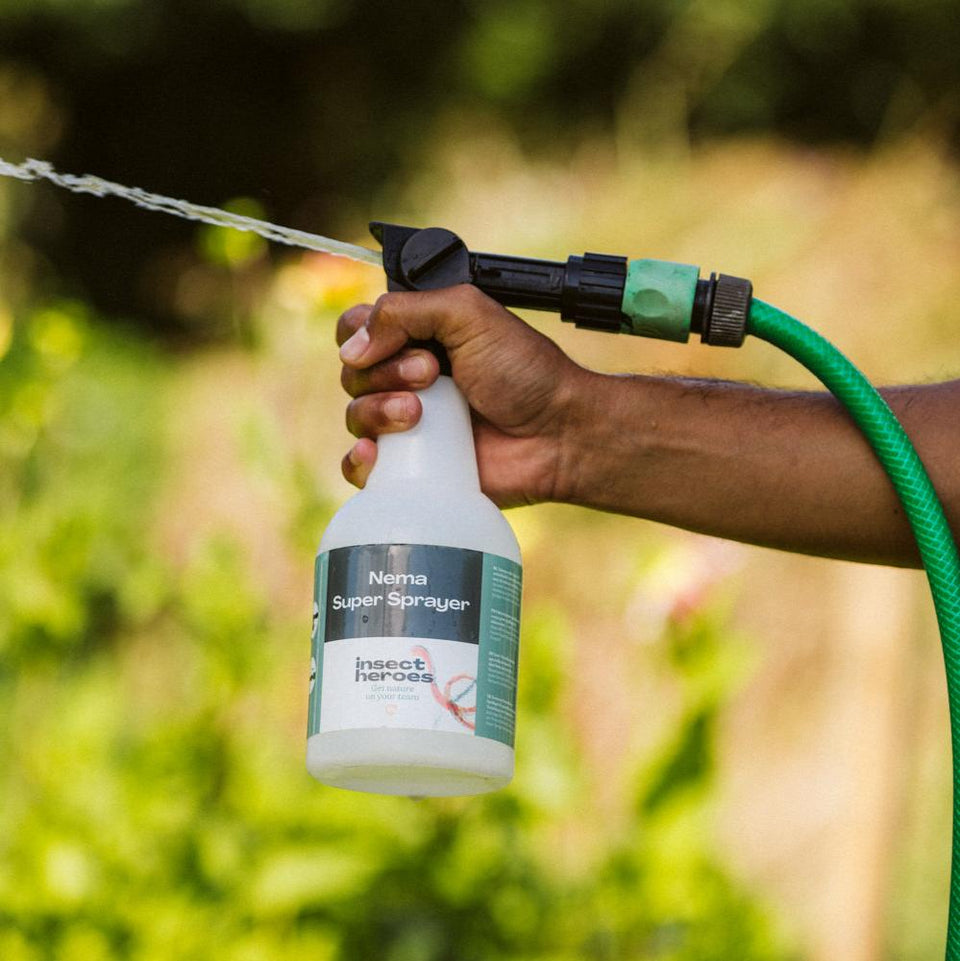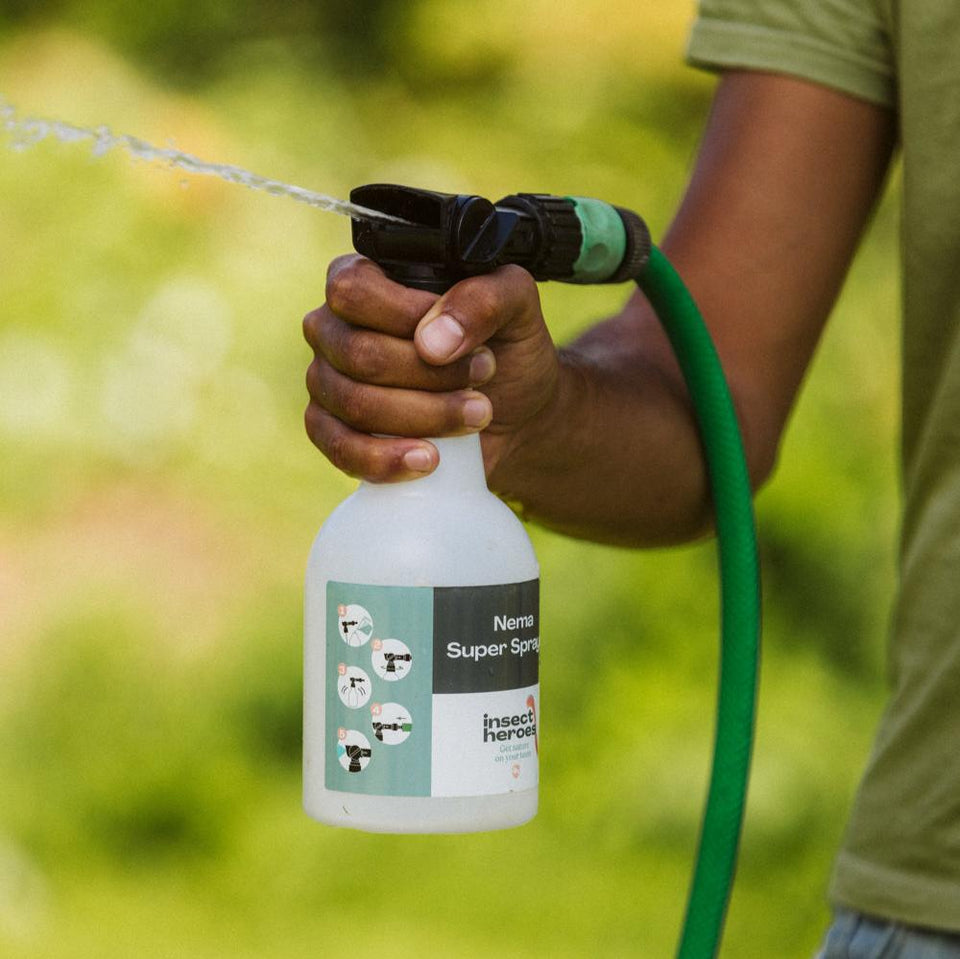Recognize, combat and prevent vine weevil
Taxuskever herkennen
Volwassen taxuskever herkennen
De taxuskever, ook wel gegroefde lapsnuitkever genoemd, is een kleine zwarte kever van 7-10 mm lang met lichte vlekjes op het dekschild. Volwassen taxuskevers komen rond mei tevoorschijn. De kevers kunnen niet vliegen en zijn in de schemering of 's nachts op bladeren te vinden. Overdag verstoppen ze zich bijvoorbeeld in plantenpotten of onder stukken hout.
Taxuskeverlarve herkennen
Van juli tot oktober legt de taxuskever eitjes, waar larven uit kruipen. De larven zijn 1 tot 12 mm lang.
De larve van de taxuskever vertoont gelijkenissen met de larve van de bladsprietkever (engerling) of de langpootmug (emelt), maar er zijn ook opvallende verschillen. Taxuskeverlarven zijn melkwit van kleur met een bruine kop, in tegenstelling tot de emelten. Daarnaast hebben taxuskeverlarven geen pootjes, wat hen onderscheidt van engerlingen. Wanneer een taxuskeverlarve verstoord wordt, zal hij zich oprollen tot een C-vorm.
Taxuskever ontwikkeling
De volwassen taxuskever legt vanaf juli tot oktober eieren in de grond. De ronde, witte eitjes zijn maar 0,7 mm groot.
Na twee weken kruipen uit de eitjes witte larven met een bruine kop. De larven zijn dan 1 mm groot. De larven voeden zich met plantenwortels en groeien tot 12 mm lang. De larve overwintert en zodra de temperatuur stijgt, verpopt de larve zich in het voorjaar rond april.
Vanaf mei kan je schade van de volwassen taxuskever waarnemen. De volwassen kever is 's nachts actief en neemt ronde happen van de zijkant van bladeren. Na een maand is de taxuskever volwassen en kan ze eieren leggen. De cyclus is weer rond.
Taxuskever schade
Er zijn verschillende manieren waarop de taxuskever schade kan aanbrengen aan planten.
Schade door de volwassen taxuskever
De schade van de volwassen taxuskever is het duidelijkst te zien. De taxuskever voeden zich 's nachts van de bladeren van verschillende soorten planten zoals taxus, rododendron, cyclaam en azalea. De kever neemt ronde happen van de zijkant van de bladeren, waardoor de planten er erg onaantrekkelijk uit kunnen gaan zien.
Schade door de taxuskeverlarve
Onder de grond, onzichtbaar voor mensen, leven de larven van de taxuskever in de grond. Zij smullen heerlijk van de wortels van planten. Dit is natuurlijk schadelijk voor de plant, en kan de plant laten verzwakken of zelfs laten sterven.
Taxuskever bestrijden op natuurlijke wijze
Taxuskevers kun je eenvoudig en effectief bestrijden met twee verschillende producten: Felti aaltjes of Phora aaltjes. Welk aaltje je moet kiezen hangt af van het seizoen. Bij het product vermelden wij altijd de minimale bodemtemperatuur waarbij de aaltjes gebruikt kunnen worden.
Larven van taxuskevers bestrijden
Je kunt de larven van taxuskevers effectief bestrijden met behulp van aaltjes. Aaltjes zijn microscopisch kleine wormen die de larven van de taxuskever parasiteren, wat uiteindelijk leidt tot hun dood. De aaltjes worden geleverd in een kleiachtige substantie die opgelost kan worden in water. Giet de oplossing van aaltjes en water over de potgrond, en laat de aaltjes het werk doen.
Volwassen taxuskevers bestrijden
Volwassen taxuskevers kunnen helaas niet effectief worden bestreden met aaltjes, omdat hun pantser moeilijk doordringbaar is voor deze kleine organismen, in tegenstelling tot de zachte huid van de larven. Een effectieve methode om volwassen taxuskevers te vangen, is door een plank met groeven onder een aangetaste struik of plant te leggen. Tegen het einde van de nacht kruipen de kevers onder de plank om zich in de groeven te verschuilen. Hierdoor kunnen de taxuskevers overdag eenvoudig worden verwijderd.
Wanneer de taxuskever bestrijden
Aaltjes (nematoden) tegen de taxuskever kun je het beste gebruiken in de periodes wanneer de larven van de kever actief zijn en gemakkelijk kunnen worden bestreden. Dit zijn de meest effectieve tijdstippen:
Voorjaar (halverwege maart tot halverwege mei)
In deze periode komen de overwinterde larven uit hun rustfase en beginnen ze zich te voeden. Dit is een goed moment om aaltjes in te zetten, omdat de larven dan kwetsbaar zijn. Felti aaltjes kunnen al ingezet worden vanaf 8 ºC.
Zomer (augustus)
In augustus zijn er jonge larven die uit hun ei kruipen. Deze larven zijn nog klein en daardoor extra gevoelig voor parasitering met aaltjes. Het meest effectief is om Phora aaltjes in te zetten.
Najaar (oktober)
Oktober is de laatste periode waarin je aaltjes kunt inzetten voordat de winter intreedt. Door in het najaar aaltjes in te zetten, verminder je de kans dat de larven overwinteren en in het voorjaar voor nieuwe schade zorgen. Dit kan een belangrijke bijdrage leveren aan de controle van de taxuskever op de lange termijn.
Hoe kan ik de bodemtemperatuur controleren?
De gemiddelde bodemtemperatuur kan je opzoeken op de website van het KNMI of op buienradar.
Taxuskever voorkomen
Je kunt taxuskevers op verschillende manieren voorkomen. Door een combinatie van deze methoden toe te passen, kun je de kans op een taxuskeverplaag aanzienlijk verminderen en je tuin gezond en vrij van deze schadelijke kevers houden.
Aaltjes preventief inzetten
Een effectieve manier om taxuskevers te voorkomen is door preventief aaltjes bij de bodem van de aangetaste planten te voegen. Voeg de aaltjes toe aan de hoeveelheid water die je normaal aan de plant geeft.
Aantrekken van natuurlijke vijanden
Bevorder de aanwezigheid van natuurlijke vijanden van de taxuskever, zoals vogels, egels, en loopkevers. Dit kan door je tuin aantrekkelijk te maken voor deze dieren, bijvoorbeeld door het plaatsen van vogelhuisjes en het creëren van beschutte plekjes.
Gezonde tuin
Houd je tuin gezond en stressvrij voor de planten door ze goed te onderhouden. Gezonde planten zijn beter bestand tegen plagen. Regelmatig snoeien, water geven en bemesten kan helpen om de weerstand van de planten te verhogen.
Bestendige planten
Kies voor planten die minder aantrekkelijk zijn voor de taxuskever. Hoewel de taxuskever een breed scala aan planten aanvalt, zijn sommige soorten minder vatbaar zoals lavendel, geraniums, hertshooi, anjers of salie.
Volwassen taxuskevers vangen
Door de volwassen taxuskevers te vangen, voorkom je dat de kevers eitjes kunnen leggen. Leg een vochtige doek op de grond en plaats een houten plank met groeven erover. De taxuskevers zoeken 's nachts beschutting in de groeven. Til de plank dagelijks op om de kevers te verzamelen.
Andere manieren om taxuskevers te bestrijden
Taxuskevers bestrijden met knoflook
Het gebruik van knoflookextract als een natuurlijk insectenwerend middel kan helpen om taxuskevers af te schrikken. Het grote voordeel van deze methode is dat het een natuurlijke en niet-giftige oplossing is, die geen schadelijke effecten heeft op de omgeving, huisdieren of mensen. Knoflook is ook relatief goedkoop en gemakkelijk verkrijgbaar. Aan de andere kant is een nadeel van deze methode dat het afschrikken minder effectief kan zijn bij een zware besmetting en dat herhaalde toepassingen nodig zijn om effectief te blijven. Bovendien biedt knoflookextract geen directe oplossing voor de larven, wat betekent dat het probleem niet volledig wordt opgelost.
Taxuskevers bestrijden met chemische middelen
Het gebruik van chemische insecticiden kan een snelle en effectieve oplossing bieden voor de bestrijding van taxuskevers, zowel voor de volwassen kevers als de larven. Deze middelen kunnen een sterke daling in de populatie van taxuskevers veroorzaken binnen een korte tijd. Echter, de nadelen wegen vaak zwaar: chemische middelen kunnen schadelijk zijn voor het milieu, niet-doelsoorten zoals bijen en andere nuttige insecten doden, en residuen achterlaten die planten en de bodem kunnen vervuilen. Dit in contrast met de meer duurzame aanpak van aaltjes tegen de larven. Kijk op de verpakking altijd naar de samenstelling. Let op giftige stoffen zoals pyrethrinen, deltamethrin of acetamiprid en vermijd deze.
Taxuskevers bestrijden met koffie
Het gebruik van koffie of koffiedik om taxuskevers te bestrijden is een natuurlijke methode die werkt door de kevers af te schrikken. Een belangrijk voordeel van deze methode is dat het milieuvriendelijk en veilig is voor andere organismen in de tuin. Koffie is bovendien gemakkelijk toegankelijk en goedkoop. Het kan ook bijdragen aan de bodemvruchtbaarheid wanneer het wordt afgebroken. Een nadeel is echter dat de effectiviteit van koffie tegen taxuskevers niet wetenschappelijk bewezen is en mogelijk varieert. Het kan ook nodig zijn om regelmatig nieuwe koffie toe te voegen om de werking te behouden. In vergelijking met aaltjes, die specifiek en bewezen effectief zijn tegen de larven van taxuskevers, biedt koffie een minder zekere en mogelijke tijdelijke oplossing.
Weet je niet zeker van welke plaag je last hebt?
Bekijk de overzichtspagina met alle plagen.





















































